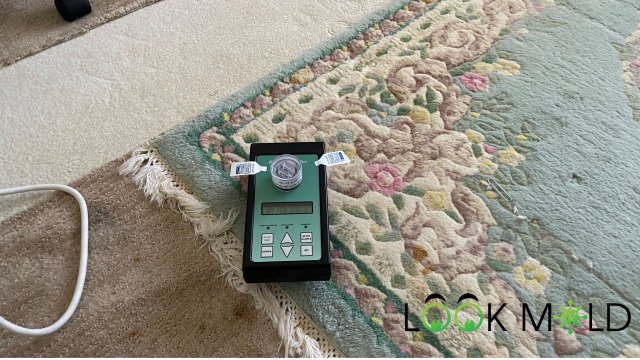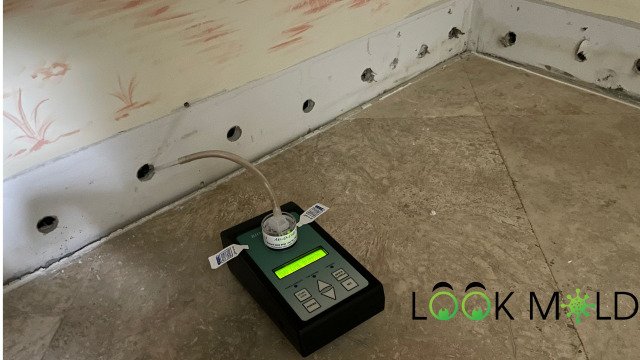Air Quality Testing for Mold: What You Should Know
Expert insight by: Brad Fishbein, Licensed Mold Assessor
Updated April 5, 2025
If you’ve ever thought, “Do I have mold in my air?” — you’re not alone.
Air quality testing for mold is one of the most common tools used to figure that out. It’s quick, simple, and can help confirm if there are invisible spores floating around your home.
But let me be upfront with you:
Air testing is not a magic bullet.
I’m Brad Fishbein — licensed mold assessor and founder of Lookmold.com — and I’m going to walk you through when air testing works, when it doesn’t, and how to use it the right way.
What Is Air Quality Testing for Mold?
Air quality testing involves using a negative air pump and a cassette (called a spore trap) to collect a sample of the air in your home.
That sample is sent to a lab where a microbiologist examines it under a microscope. They’ll tell you:
- How many mold spores are in the air
- Which types of mold they are (like Cladosporium, Aspergillus, or Stachybotrys)
Most air pumps are calibrated to pull in 75 liters of air in 5 minutes, but sampling can vary between 2 to 10 minutes depending on the equipment.
Once you get the results back, you’ll see how many spores per cubic meter were found — and whether those levels are normal, elevated, or alarming.
What Can Air Testing Actually Tell You?
Let me be real with you:
Air testing can confirm if mold is airborne, which is important if you’ve had:
- Water damage
- Known mold growth
- HVAC issues
- Allergy symptoms
But it won’t always detect hidden mold in walls or behind baseboards. That’s because mold isn’t always airborne — especially if it hasn’t been disturbed.
That’s why a full mold inspection is critical before and after any mold remediation.
Air testing should never be used on its own to determine if your home has a mold problem. It’s just one piece of the puzzle.
When Should You Test Air for Mold?
You should consider indoor air sampling when:
- You’re experiencing symptoms (itchy eyes, coughing, fatigue)
- You’ve had a leak or flood
- You’re concerned mold may have traveled through your HVAC system
- You’re buying a home and want extra peace of mind
- You suspect black mold (Stachybotrys)
Air testing is especially useful when paired with other methods like visual inspections, moisture mapping, and surface sampling.
Can You Do It Yourself?
Technically? Yes.
Should you?
Probably not.
A mold professional will:
- Create a solid sampling plan
- Know where to test and why
- Accurately interpret the lab report
I’ve seen so many homeowners try a DIY kit only to misread the results or panic over harmless spores. Spend the money on a qualified inspector — it’ll save you stress and second-guessing.
Where Should Air Samples Be Taken?
Every room? Not necessary.
Here’s how a pro decides where to test:
- Take a sample near known mold growth (e.g., moldy cabinet or drywall)
- Take a sample in a non-affected room to compare
- Take an outdoor sample as a baseline
- Possibly sample an adjacent HVAC zone
Air testing is only valuable when it's strategic — not just random.
Different Types of Air Samples
📌 Ambient Air Sampling
The most common. You set the pump in the room and collect 75 liters of air in 5 minutes.
📌 Pat Sampling
You “pat” a cushion, carpet, or piece of furniture to stir up any mold particles — then run the air pump.

📌 Wall Cavity Sampling
You use a tube to collect air from inside a wall — through a small hole or an outlet box.

⚠️ Warning: Wall cavity samples can cause false positives due to dust and construction debris.
Limitations of Air Testing
Air testing is helpful — but here’s what it can’t do:
- Detect mold trapped inside walls or floors
- Pick up mold toxins (mycotoxins) in the air
- Give a complete picture of your home’s mold risk
- Stay accurate 24/7 (it’s only a snapshot in time)
Mold counts can fluctuate hour to hour depending on cleaning, airflow, humidity, and even weather.
Air testing is just one tool. Don’t rely on it alone.
What Does the Lab Report Show?
Your lab report will list:
- Mold species
- Raw count
- Spores per cubic meter (M³)

But here's the thing:
There are no official legal limits on how much mold is “too much.” You have to compare your indoor levels to outdoor and look at the species.
Example: Even small amounts of Stachybotrys can be cause for concern.
If you’re unsure how to read your lab results, your inspector (or lab) should walk you through them.
How Much Does Mold Air Testing Cost?
You’ll pay for:
- The inspector’s time or a test kit
- Spore trap cassettes ($10–$15 each)
- Lab analysis ($40–$60 per sample)
👉 Here’s a breakdown of inspection costs
Expect to pay $250–$500 total for professional air testing, depending on how many samples are taken.
Final Thoughts from Brad
Here’s my honest take:
Air quality testing is a great tool — when used correctly. But it’s not a standalone solution.
If you're going to test your air, make sure you:
✅ Pair it with a full mold inspection
✅ Sample both indoor and outdoor
✅ Work with a licensed mold professional
Explore Related Topics:

Meet the author: Brad Fishbein is an ACAC council-certified Microbial Investigator. In the fall of 2012, he became a Licensed Mold Assessor in the State of Florida through the Department of Business & Professional Regulation. Brad has helped homeowners with over 5,000 successfully completed Mold Inspections since 2009.

